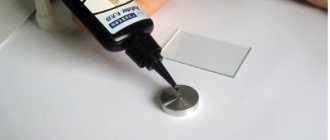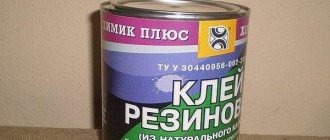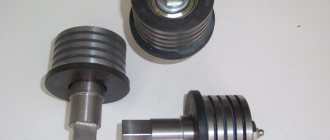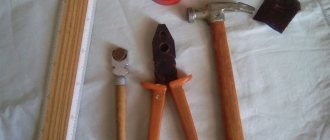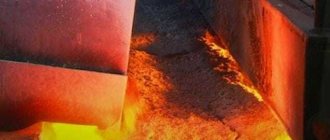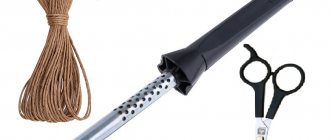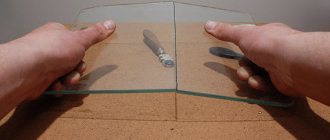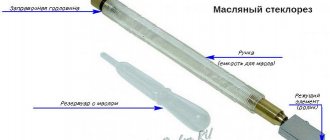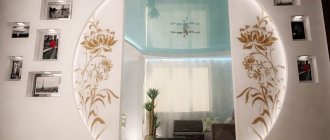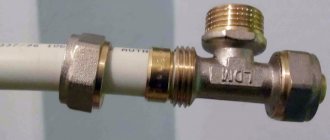Preparation of material and tools
The tabletop can be cut from transparent, frosted, textured, tinted glass or mirror cloth. Transparent glass visually expands the interior of the room. A colored countertop can be an organic addition to the decor of the room. A dark color will create a “glamorous” style. A kitchen table with black glass, complemented by white chairs, will look impressive.
If you have no experience in making furniture, it is better to make a table with your own hands with a solid tabletop and metal legs. Having mastered the technology of working with such material, in the future you will be able to figure out how to make a table from glass of a more complex type.
To make a high-quality table you will need:
- sheet of glass;
- metal legs;
- suction cups for attaching to the tabletop;
- wood glue for metal and glass;
- gloves and safety glasses;
- metal-glass glue, polishing paste.
Tools for cutting glass: 1 – square; 2 – corborundum stone; 3 – compass for cutting glass; 4 – pliers; 5, 6, 7 – glass cutters.
- diamond or roller glass cutter;
- pliers with rubber pads;
- metal ruler of suitable length;
- grinder (grinder), drill;
- grinding discs, felt wheel;
- pencil for marking.
- file (emery block).
Glass should be purchased tempered, 6-12 mm thick. It must be clean and dry when cutting. On dirty material, the cut may be uneven. Having decided on the location of the homemade piece of furniture, plan its dimensions. Apply the accepted dimensions to the sketch. Mark the mounting locations for the legs.
Return to contents
Repairing a glass table is not an easy procedure. The fact is that, due to its transparency, the glass table shows all the mistakes that you may make while working. For this reason, you must act very carefully. The most popular problem among owners of such a product is getting rid of scratches. In order to avoid this, you need to properly care for the table.
Read also: Do-it-yourself dust collector for an angle grinder
Glass table (option 1) Glass table (option 2) Glass table (option 3) Glass table (option 4) Glass table (option 5) Glass table (option 6)
If you want to remove scratches and scuffs from glass, you can't do without valuable advice. Scratches spoil the appearance of the product, which had a neat appearance before this unpleasant incident.
1. Try toothpaste 2. Try ammonia solution 3. For deeper scratches 4. You can try jewelry polishing paste and pad
How to remove hated defects? First, prepare GOI paste. This special glue is sold in automotive stores. Pasta is sold by number. For glass products we will need the first or second number.
In order to get rid of cracks in glass, you need to grind the paste until it becomes crumbly. At the same time, it must be given homogeneity. Polish out any imperfections. In order to remove them, you need to dip a cotton swab into the crushed paste. You need to polish the scratches carefully, without pressing the stick. The procedure is repeated several times, and its duration is about ten seconds. Once polishing is complete, remove excess paste from the glass.
MDF facades are usually called film furniture facades based on MDF boards (MDF - Medium Density Fiberboar), covered with PVC films. Film facades can be “solid” or have through cutouts for the installation of various functional and decorative elements (glass, mirrors, plastic, etc.). Facades of this type - with a through cutout - are called “showcases”. Below we will consider two methods of fixing glass in a film display facade, both in the case of a special recess (recess, groove) for glass, and without it.
In the absence of sampling, the glass is secured mechanically with an overlap - using plastic L-shaped fasteners and self-tapping screws. At the same time, the glass should have slightly larger dimensions (approximately +10 mm per side) than the cutout in the facade. This is the simplest and least aesthetic way to fasten glass.
Plastic L-shaped fastenings for glass.
Sampling for glass is carried out at the production of facades, before wrapping them in film. It is difficult to make a high-quality sample on a finished façade (which did not have a sample initially), and there is a high risk of damage to the film; It is not recommended to do this without extensive experience. As a rule (not always), a film façade display window has the following dimensions: the distance from the outer boundaries of the façade to the cutout is 60 mm, the recess depth is 9 mm, the recess radius is 9 mm, the recess height is 5 mm (for glass up to 5 mm thick inclusive). It is not difficult to calculate the dimensions of rectangular glass for a facade of any size. If H is the height of the facade, L is the width, then the glass height h = H-60×2+9×2- 2 = H-(120-18+ 2 ) = H-104, where 2 is the required gap for free entry glass into the seat (sampling) and compensation for possible small inaccuracies when cutting glass and/or manufacturing the facade. By analogy, glass width l = L-104. For example, if the display facade has external dimensions of 720×396 mm, then the glass should have dimensions of 616×292 mm. Also, the glass must have rounded corners with a radius of 9-10 mm (the radius of the rounding may depend on the facade manufacturer). There is no need to process (grind after cutting) the ends of the glass; you can only blunt it slightly for safe installation. The glued glass should be either flush or slightly recessed relative to the rear plane of the facade (protruding glass looks unsightly).
Typical dimensions for a display facade. Dimensions may be different (depending on the facade manufacturer).
Showcase facade made of MDF. The holes for the hinges are pre-drilled (recommended).
Sampling for glass close-up.
Rounded glass corner (R10).
Gluing glass into the facade.
Required tools and materials:
- Silicone sealant, colorless (plumbing or universal).
- Acetone or pure gasoline for degreasing.
- Clean cloth (not synthetic).
- A sharp knife with a thin blade.
Acetone and a clean cloth.
Silicone sealant.
Step 1. We try on the glass, placing it in its place in the groove of the facade. The glass should fit freely into the groove and have a slight free movement. The rounding radii of the glass corners should approximately correspond to the rounding radii of the façade sample (+/- 1 mm).
Glass (corrugated) for the facade.
Step 2. Lay the façade face down on a clean, flat, soft, non-slip surface. Nearby we place the glass up with the side on which we will apply the sealant. We clean the facade sample and the perimeter of the glass from dust. We saturate a clean cloth with acetone and wipe the edges of the glass and the facade with it.
Step 3. Apply a thin, even layer (without breaks) of sealant to the edge of the façade. You can put a little more sealant in the corners of the sample.
Applying sealant.
Step 4. Carefully take the glass in your hands, trying not to touch the grease-free edges. We turn it over with the fat-free side down and slowly (don’t throw it!) put it into the groove of the facade. The front can be hung slightly over the edge of the table so that the glass can be supported by hand through the cutout in the display case. By lightly pressing on the glass, we observe the spreading (flattening) of the sealant, which indicates that there is a sufficient amount of it. We align the glass in the sample, trying to make the gaps the same - estimated 2 mm on each side. Leave the facade in a horizontal position for at least 24 hours. All work should be carried out at temperatures above +5°C (see instructions on the sealant packaging).
The glass is in its place.
The dimensions of the gaps are observed.
Step 5. After the sealant has cured, the glass should firmly adhere to the facade along the entire perimeter of the sample. After which, very carefully, trying not to damage the decorative film, you need to remove excess sealant on the front side of the facade with the sharp tip of a knife.
As a rule, corrugated glass has only one plane, the other is smooth. Which side of the glass will be the front (corrugated or smooth) has a purely aesthetic meaning. However, you need to remember two things. Firstly, for reasons of reliability, it is recommended to glue glass with deep corrugation on the smooth side. Secondly, it is more difficult to remove dirt from the corrugated side of the glass, which is especially important for kitchens. Gluing glass, mirrors or other similar material into a film facade does not require special skills, but is a responsible operation, the quality of which determines the safety of furniture operation. If the technology is followed, the reliability of the adhesive silicone seam is not inferior to plastic fastenings with self-tapping screws.
Similar articles:
- DIY vacuum press. Part VI. Electrical control cabinet
- How to seal an air mattress
- DIY vacuum press. Part IV. Vacuum system
- DIY vacuum press. Part III. Vacuum table
- DIY vacuum press. Part II. bed
- DIY vacuum press. Part I. Introduction
- Gluing the melamine edge
- Experiments with epoxy glue
Repairing a wobbly table
In order to repair a table leg that is wobbly, you need to understand the fasteners. The legs of the table were glued at the factory with a special glue, which may dry out over time. If the legs are secured with dowels, screws, screws, etc., they can simply be unscrewed and replaced. The legs can be glued if the tabletop is attached to them with adhesive bonds. In order to get to the damaged elements, the table is turned over in disassembled form. The screws are unscrewed from the tabletop itself. If a crack has formed on the leg under the tabletop, it can be glued. Place glue into the crack and cover it with a countertop.
If the glass tabletop is on a wooden frame
Glass table on wooden legs
We completely disassemble the base. We clean the old dowels from the old glue, apply new glue and put it in place. You can secure the loose leg with this tie. Screw the pin into the leg and tighten the tie plate into place with self-tapping screws.
You can strengthen the connections with metal elements. Give preference to the dowel. Insert one end of it into the cleaned hole, and sharpen the other so that it fits smoothly into the connection. Now you need to assemble the product. If you have never assembled it before, watch the video.
Glass table care
Taking care of a glass table
In order for the product to serve you as long as possible, it will require proper care. How to care for a glass table? First you need to figure out how to protect it from damage. If you cleaned the room, the table must be set. This will protect it from dust and possible damage. It is necessary to find a special approach to the glass table - wipe it with special compounds, protect it from exposure to direct sunlight and temperature changes.
If you have small children, a glass table could put their lives at risk. To prevent children from getting hurt or accidentally breaking the product, move the table away from children's games. It is best to install a glass table in places where it will be least exposed to household occupants. Pets are another risk to the existence of glass products. Fluffy fidgets can both break and scratch the table. For this reason, it is better to keep them away from the product. As you can see, if you properly treat a glass table, this piece of furniture can serve you for many years.
To glue glass to metal at home, you need to act very carefully and know several subtleties of the process, in particular, what exactly to glue. Glass is a delicate material, its properties affect how surfaces adhere to other matter.
When gluing, you need to pay attention not only to the use of methods for good adhesion of the glass surface and metal, but to maintaining the appearance of the product. Taking into account the product and the amount of work, they determine what can be used to glue the glass to the metal.
There are several types of glue for gluing:
- UV glue and UV lamp;
- Super glue;
- special adhesive type B 682-0, Verifix MV 750;
- epoxy adhesive;
- automobile;
- Moment;
- transparent silicone sealant.
How to use
When working with glass glue at home, you need to follow several rules. First of all, act carefully, as stains may remain on the transparent material. Hardened drops of glue are very difficult to remove from the front surface. Glass is a fragile material, so there is no need to subject it to unnecessary stress. Another important point is skin protection. It is necessary to use protective gloves and a mask, especially if the adhesive products contain toxic substances.
How to glue glass correctly :
- First of all, you need to prepare the surface. The result of gluing depends on its purity. Before starting work, the glass must be degreased: wipe with solvent, rinse with soapy water and wipe dry. Sometimes the surfaces are polished (for smooth joints).
- How to glue parts: both parts are covered with a layer of glue, if necessary, soaked, and then pressed tightly against each other for a while. Sometimes it is enough to lubricate only one part, usually a smaller one.
- For complete polymerization, you need to leave the item for a day in a dark place. If UV glue is used, the bonded product is placed under a special lamp.
- If excess glue appears, it can be cut off with a sharp construction knife or blade.
- Before use, the glued product should be wiped with a damp sponge and dried. If the packaging does not indicate that the composition has water-repellent properties, then it is better not to wash the glued object with water.
Advice! The glue is applied carefully and in a thin layer. Excess will be difficult to remove.
The exact drying time varies between different adhesive materials. The manufacturer indicates on the label the procedure for working with the glue, the speed of its setting and complete hardening. Working with glue depends on the type of packaging. If the tube is not equipped with a convenient nozzle, it is recommended to use a brush. To glue small decorative elements, they can be held with tweezers and immersed in a drop of glue.
Using UV Glue
Often in the process of renovating an apartment, when a glass product or piece of furniture breaks, a situation arises when you need to know how to glue the metal to the glass. One way to remedy the situation when there is a large volume of work is to use an adhesive that contains a component such as methacrylic urethane resin. In addition, the work requires a special UV lamp, a degreasing compound and an industrial hair dryer.
Read also: Router for end mills
In order for the parts to be glued to stick better, you need to polish and thoroughly treat the surfaces with a degreasing compound. What to replace it with? For these purposes, you can take regular alcohol. The next step is to heat the parts for gluing at the joining point a few degrees above room temperature.
Apply the adhesive and turn on the lamp for a few minutes. To apply the glue exactly to the right place, you can mark it with a marker. After hardening, the glue will become transparent and invisible at the attachment point. This must be taken into account if you need to glue not transparent glass, but frosted or colored glass.
The method of using UV glue and a lamp is considered expensive; its use is advisable if all components are present or there is a large gluing area.
Preparation for work and gluing nuances
When a gluing method has already been chosen, this does not mean that a positive result is guaranteed. High-quality training and competent work technology are of great importance.
- The necessary measurements are taken and the configuration of the elements that need to be connected is determined. During repairs, this will not be required, but when creating a new product, this must be done in advance so as not to be distracted once again.
- When, for example, you need to glue a mirror to a cabinet door, you must first make markings. This will ensure both reliable and attractive results.
- All surfaces should be thoroughly cleaned. Dirt and old glue must be removed, otherwise they will interfere with normal adhesion and reduce the adhesion of the glue.
Approximate diagram of gluing stages:
- First of all, you need to eliminate cracks and irregularities. It is better to putty them.
- Then, the surface must be cleaned with fine sandpaper.
- The next stage is very important - the surface is degreased. There are special solutions for this. It’s easy to do: dampen a cloth and wipe the glass and wood with it.
- The process is completed by applying glue and bonding. When using “liquid nails” or PVA, apply glue to only one surface. Then the glued elements are tightly compressed and fixed for the required time.
By the way, if a two-component version is used, glue is applied to one item and an activator is applied to the other. After compression, a reaction occurs and the glue hardens.
After reading the article, you can understand what kind of glue should be used for gluing glass and wood, as well as how to properly organize the work process. Perhaps one of the readers knows other options for gluing such elements. Share your secret in the comments, it will probably be useful to other people.
Did you like the article? Subscribe to us in Yandex Zen. By subscribing, you will be aware of all the most interesting news. Go and subscribe.
Bonding parts of kitchen appliances
Sometimes situations arise when you need to repair the oven or microwave door. If you decide to do this at home, the question arises: what glue should I use to glue the metal to the glass?
When choosing a connection agent, you need to pay attention to the following indicators:
- high degree of adhesion;
- elasticity;
- neutrality and exclusion of toxic emissions;
- heat resistance.
Specialized stores sell sealants for repairing kitchen appliances or glue with a silicone composition. For these purposes, you can purchase Dow Corning, but you can’t find it everywhere.
According to people who have encountered such a problem, there are other means that are no worse than imported ones, and in some ways better. Some suggest using an organosilicon compound based on rubber. This product does not emit toxic fumes, hardens without additional processing and can withstand temperature changes. It is up to the consumer to decide which product to use.
To glue glass in an oven or hob, clean the joints and dry them. Then apply glue to the metal according to the attached instructions. When repairing an oven, you have to carefully coat the metal joints, removing excess glue immediately, otherwise, after it hardens, it will be possible to remove smudges only with a special means.
Other craftsmen have found other ways to glue metal to glass:
- glue HC-1 and HC-2,
- glue BK-4,
- silicate glue,
- sealants for cars.
Auto glass
Car drivers often face the problem of replacing broken glass in their car. Of course, it is better to use the services of workshops, but every car owner should know the principle of replacement.
To glue glass to metal, treat the gluing areas with a pneumatic knife, removing fragments and old glue. Clean and degrease the body at the junction. The glass is treated with some kind of activator and automotive glue is applied.
Gluing glass to metal yourself is not difficult if you use the appropriate types of glue for the job and follow the instructions. You can repair glass tables, ovens and other items at home.
If you are tired of the old wooden tabletop, you can replace it with a glass one or make a glass table with your own hands. Many craftsmen are faced with the problem of attaching a new countertop. You will learn how to fix the glass on the table in this article.
How to connect glass objects: types of glue
Glass glue is divided into several types, intended for different cases:
- Polymeric. Dries under the influence of ultraviolet rays. When choosing such glue, you need to take into account the color of the glass: at least one of them must be transparent for light access. The surfaces to be glued are placed under a special lamp until the seam is completely hardened. Advantages of polymerizing compositions: the adhesive seam is transparent, withstands temperature changes, humidity, and mechanical loads. This composition is used to glue shop windows, stained glass windows, and jewelry together. This is one of the strongest glues, but its disadvantage is that it takes a long time to dry.
- Silicate glue is made on the basis of silicone and sealant. Its scope of application is construction. A special feature of the glue is its assortment of colors, which allows you to make the seam invisible or decorative. Therefore, silicate glue is very attractive for needlework. The thicker the layer, the higher the adhesion strength.
- Cyanoacrylate, or cold welding. The advantage of this type is high adhesion and quick drying. The result is durable and strong. Cyanoacrylate adhesives are used on painted surfaces and can connect glass to other types of materials: wood, plastic. Minus - the composition does not withstand contact with water.
- Household: the familiar PVA, BF-2 and BF-4 adhesives, as well as Moment glue. PVA is used to fasten small parts. The reliability of such a connection depends on the compression force of the materials. BF series adhesives operate at high temperatures, which makes them difficult to use for glass, which may not withstand such a load. If you take “Moment”, then the surfaces are first lubricated and left for 20-30 minutes, and only then connected - this way the strength will be higher. “Super Moment” is the best option for instant gluing when there is no time to wait for drying.
- Heat-resistant glass adhesive is used for items that will subsequently be regularly exposed to high temperatures. These are electric kettles, ovens, stoves, etc. The adhesive seam does not change under the influence of heat due to the addition of special amplifiers to the composition.
What is a glass table cover?
There are two types of glass top tables:
- Many people purchase glass tables with a monolithic top.
- There are also transformable tables that can increase the length of the tabletop.
Important! This option is indispensable for a large family. In addition, it is ideal for a home holiday feast.
Such coatings are made from three types of glass:
- Tinted. This option attracts more attention from visitors to the home. Using this coating, you can highlight the interior of the room in which the piece of furniture is located.
Important! It will look very original if you add black chairs to a black glass table in the kitchen.
- Matte. In this case, the glass takes on a slightly greenish color, as it is natural for such a material.
- Glass. In the interior of any room, such a design seems weightless and not as bulky as it actually is, and this adds a certain lightness and airiness to the room.
Read also: Repair of jigsaws in Moscow
Features of the work
If you have chosen one of the options described above, this does not mean at all that the result will be excellent; the correct technology for carrying out the work and high-quality preparation of the bases and elements are very important.
Preparation
First of all, you need to prepare everything you need and carry out a number of activities:
- It is necessary to take all the necessary measurements and determine what size and configuration elements will need to be connected to each other. If you are making repairs, this is not required, but if you are creating a new product, you may need to cut something to certain sizes; it is better to do this in advance so as not to be distracted again.
- If, for example, you need to glue a mirror to a cabinet door or decorative elements, then you need to mark their location in advance; this is very important so that the result is not only reliable, but also attractive. Mark the marks ahead of time so you already have an idea of what you want the end result to look like and don't have to think about it as you go.
Pros and cons of the material
Before you move on to attaching the glass tabletop to the table, you need to understand all the advantages and disadvantages of the material you have chosen.
Let's start with the positive aspects:
- Original design. Glass tables make a very good impression and lift the mood of both residents and guests. This table looks especially great in a high-tech style interior.
- Resistance to external irritants. Many users are afraid to buy a countertop made of this material for fear that the glass may break. In fact, such a coating can be much stronger than wood.
- Moisture resistance and temperature resistance. Tempered glass is not frightened by actively changing environmental conditions.
- Easy care. Such tables are very hygienic and easy to care for, including removing coloring and greasy substances, which is a definite plus. For the same reason, ordinary wooden kitchen tables are inferior to glass-topped tables.
Before you attach the glass to the table, think about it, because this surface also has some minor disadvantages:
- There are many stains and marks left on the surface. This problem can be solved by purchasing a matte countertop.
- Even the smallest dirt is visible. You have to remove all the stains with a liquid designed for cleaning glass.
- The coating can be easily scratched.
- Creates a lot of noise when paired with kitchen utensils.
- High price.
Types of compositions that are used during work
Let us immediately note that there are many possible options, but most of them are intended for professional use and are difficult to find on the open market. We will consider only those types that can be bought in hardware stores without any problems:
| PVA glue | The main advantages of this solution are its affordable price and simple instructions for use. But let’s make a reservation right away - we are talking about high-quality wood glue, and not about stationery options, which are not so reliable. It can be used to fasten small and medium-sized elements, ensuring high quality connections |
| Liquid Nails | This is a universal group of compounds, many of which allow high-quality joining of glass and wood. They are very popular among those who do the work themselves, since, having purchased liquid nails, they can be used in a wide variety of situations and for a wide variety of materials. |
| Two-component acrylic composition | This is a special adhesive for glass and wood, which has very high properties: it is resistant to heat up to 150 degrees, impact-resistant, and can withstand chemical influences without compromising its strength. For heavy structures, and where reliability is very important, this option will be the best solution. |
| Double-sided tape | An excellent solution for those who need to glue, for example, a mirror to a cabinet door or wooden surface. You just need to glue a few strips on the back side and carefully press the element |
Important! When purchasing any of the above options, the most important thing to pay attention to is the quality of the product, compliance with shelf life and the availability of documentation confirming the compliance of a particular composition with regulatory requirements.
Two-component acrylic-based adhesive for glass and wood - the best option for complex tasks
Let's move on to the attachment
Now is the time to get down to business. To do this you will have to follow this algorithm of actions:
- Make a hole at the ends of each leg.
- Attach suction cups to these holes using very strong glue.
Important! The adhesive used to attach the mirror surface will be visible through the transparent glass of the future table. In addition, such a composition takes a very long time to dry, which will be unacceptable for this work, unless, of course, there is an additional fastener on the leg.
- When the adhesive has dried, use a felt-tip pen to mark the locations of the furniture legs on the tabletop.
- Degrease the marked areas using acetone or gasoline.
- Glue the glass tabletop to the legs of the table and wait for it to fully set.
- Irradiate until the adhesive completely polymerizes.
Important! It is necessary to take into account that it will not be possible to tear off the tabletop and re-attach the glass, so it is necessary to measure everything perfectly accurately.
The glass top for the kitchen table is glued!
Exploitation
A glass tabletop needs to be handled very carefully. For this reason, it is necessary to follow a number of mandatory rules for caring for the surface:
- Such a covering is wiped only with artificial suede or a microfiber cloth - these materials leave a minimal amount of stains.
- To clean the coating, household chemicals are used, namely glass and mirror surface cleaners. This should be done approximately 1-2 times a week, as there is a risk of aggressive chemical compounds getting on the food.
- You can easily get rid of scratches by sanding the surface with GOI paste, toothpaste or Polarit.
- To prevent scratches and chips, place special napkins on the table - they are quite easy to find in stores.
PVA glue
This glue is the most popular among consumers. You can purchase it at any hardware and construction store. The price is reasonable, and the quality is quite decent. Positive properties of glue:
- PVA glue is non-flammable and does not burn.
- There are no chemicals in the composition.
- Withstands large amounts of frost and defrost.
- Not afraid of mechanical influences.
- The smell is not pungent, which makes it possible to work with it in enclosed spaces.
Let's consider a method of gluing wood to glass with PVA glue. To connect two surfaces, they must be prepared, that is, cleaned of dirt, dust and other unnecessary elements. Glass and wood can be pre-treated with alcohol or acetone. Using a brush, apply the glue evenly to both the wood and the glass. If necessary, apply a second layer, but only after the first has dried.
Some time is given for the glue to be absorbed and dry a little. Then the glass and wood need to be pressed tightly against each other. On average, you need to wait a day for strong bonding. It is advisable to place a small weight at the connection points.
Video material
A table is a key element of the interior, and it doesn’t matter whether it’s a dining table or a coffee table. Tables with glass tops look especially interesting, because the interior takes on a completely new look when such an element appears in it. From this article, you learned how to attach glass to a tabletop without glue, so that its remains do not spoil the final impression.
ATTENTION TO THOSE WHO WANT TO REGISTER ON THE FORUM. Problem activating your account? Write to (ignel(gav)mail.ru, ICQ 50389649), indicating your nickname and the address from which you registered. Don't forget to look at the forum rules. Ignorance of the rules does not exempt you from responsibility! Don't forget to look at the TB Section. Knowing the rules can save lives. Have questions about using the forum? Look for answers in the FAQ (FAQ). There's a lot of useful stuff there. Looking for interesting materials? Guide to master classes from our forum members
- Artisan »
- Our works »
- We make it ourselves (Moderator: AndyAB) »
- Topic: How to attach a glass tabletop to legs?
Author Topic: How to attach a glass tabletop to legs? (Read 89243 times)
0 Users and 1 Guest are viewing this topic.
Please recommend some glue!
Please recommend some glue!
Denis » Oct 20, 2014, 5:06 pm
Re: Please recommend glue!
shadow » 20 Oct 2014, 18:24
Re: Please recommend glue!
Tigir » 20 Oct 2014, 18:42
Re: Please recommend glue!
by toxin4ik » Oct 20, 2014 09:15 pm
Re: Please recommend glue!
Tigir » 20 Oct 2014, 21:58
Re: Please recommend glue!
kozak » Oct 20, 2014, 11:06 pm
Re: Please recommend glue!
kozak » Oct 20, 2014, 11:07 pm
Re: Please recommend glue!
by jerzypiotrowsky » Oct 21, 2014 12:01 am
Re: Please recommend glue!
Denis » Oct 21, 2014, 01:58
Guys, I know how to glue glass to chipboard. It is glued like a regular mirror using double-sided tape and liquid nails. Apparently, I should have written about glass last))) in general, what kind of glue works well with the PVC film that is glued to the glass?
The shadow, if you simply glue it with double-sided tape, there is an extremely high probability that it will fall. Experience: own rake.
Kozak, the Oracle is sticking to it so that it doesn’t turn out to be expensive technologically. Painting glass is not a cheap pleasure, and such paint is not sold here. And plus the film plays the role of armor when breaking.
toxin4ik, how does your two-component silicone work well with the film? Maybe you have the opportunity to try it out? There is enough drop for experience.
Tiger, glass area 1.35 m by 0.5 m. Thickness 4 mm. It is advisable to glue not over all areas like wallpaper, but in specific areas. Suddenly they break it. To make it easier to film.
Re: Please recommend glue!
Tigir » 21 Oct 2014, 03:07
Re: Please recommend glue!
Denis » Oct 21, 2014, 08:03
Re: Please recommend glue!
Tigir » 21 Oct 2014, 14:08
Re: Please recommend glue!
Denis » 21 Oct 2014, 15:45
Re: Please recommend glue!
Tigir » 21 Oct 2014, 16:02
Re: Please recommend glue!
Denis » 21 Oct 2014, 16:31
Who's on the forum now?
Currently viewing this forum: Majestic-12 [Bot] and guests: 0
